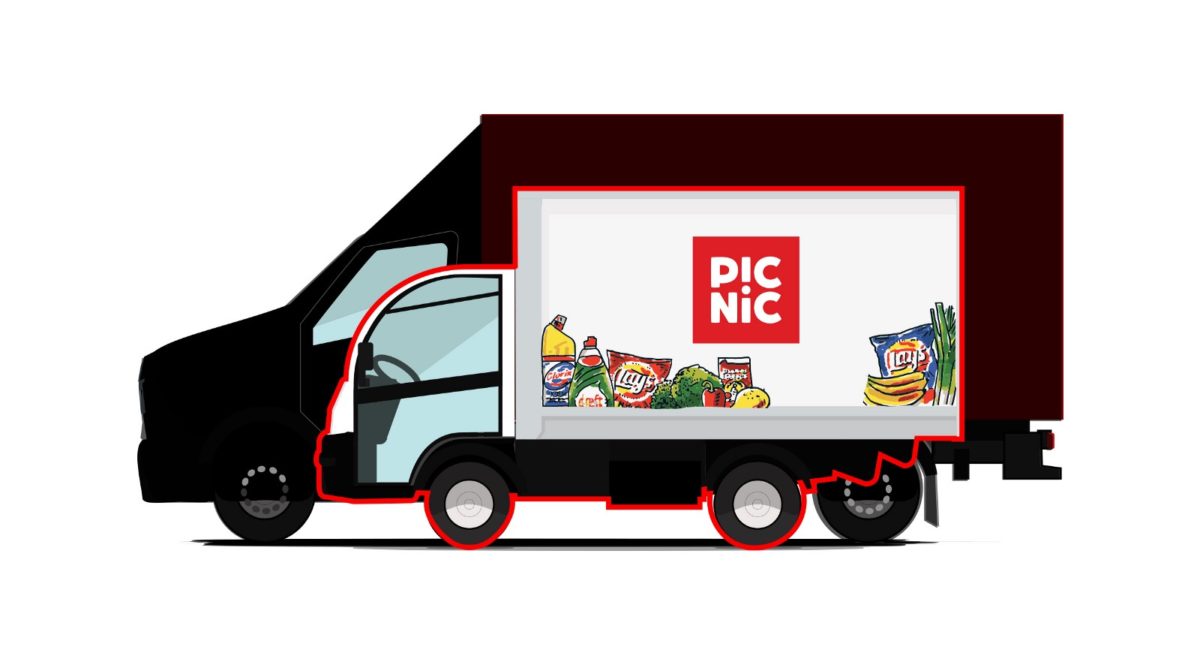The app-only supermarket Picnic redefines delivering groceries, by using small electric vehicles to deliver your groceries to your doorstep. The supermarket currently possesses a fleet of over 500 electric Picnic vehicles (ePVs). The small vehicles offer multiple advantages over Albert Heijn and Jumbo’s big trucks. Firstly the cost of electricity is far lower than the cost of fossil fuel. Secondly, the smaller size of the vehicles allows the vehicles to travel through smaller streets of inner cities, that big trucks can’t reach. Thirdly, the electric vehicles leave a much smaller carbon footprint.
In July 2018, Picnic started designing a smart grid for their delivery system in Rotterdam. The aim of this smart grid, is to create a link between the energy production, the energy storage, and finally the energy consumer. 160 ePVs are equipped with ‘smart batteries’. The batteries will be charged by solar panels located on top of the Picnic warehouses and distribution centers, where the ePVs are parked when they are not used for deliveries. The large flat roofs offer plenty of space for solar panels.
Picnic partnered up with smart energy companies Dexter Energy and Engie. The companies developed smart AI algorithms, allowing the grid system to predict the behaviour of the energy supply and demand. This way, it can be accurately calculated at what times the energy should be used. When the supply is high and the EPV batteries are fully charged, the energy is redirected to elsewhere in the hub. For example, the energy can be used to supply power for the refrigerated parts of the warehouse. If the demand is high, and the supply is high, the energy surplus can even be sold to other users connected to the smart grid.
By using such an advanced interconnected network to realise efficient energy distribution, Picnic is taking steps to quickly become a leading player in the sustainable supermarket industry. The question is: can other big players in the Dutch market like Albert Heijn and Jumbo survive if they keep using the traditional methods of grocery deliveries? Will they not fall behind if they do not capitalize on the potential of Smart Energy Grids like Picnic does?
References:
- Engie (2018) Home, Picnic start proef met opslag energie in bezorgwagentjes, Website: https://www.engie-services.nl/nieuws/picnic-start-proef-met-opslag-energie-in-bezorgwagentjes/, last visited September 16, 2018.
- Klein, A. (2018) Medium, News, Picnic Designing the Smart Grid, Website: https://medium.com/lifes-a-picnic/picnic-designing-the-smart-grid-d27a8a257d9b, Last visited September 14, 2018.
- TTM (2018) Home, News, Picnic start smart-grid proef met Engie, Website: https://www.ttm.nl/nieuws/picnic-start-smart-grid-proef-met-engie/98482/, last visited September 15, 2018.


Interesting read, I have never heart of Picnic before! I agree that sustainability is becoming a more and more important topic, especially after the introduction of the UN sustainable develeopment goals. However, I am not convinced that a business model whose USP is its “sustainability” can succeed in an industry which is characterized by price wars and very price sensitive customers. I would love to see our society caring so much about sustainability that customers would base their supermarket/purchase decisions on this factor, but I think it is still a long way to go in this regard. Therefore, I personally do not see a competitive threat for incumbents like Albert Heijn or Jumbo by Picnic.
Thanks for your interesting blog post! Very interesting how Picnic is constantly trying to innovate, even in the energy industry. I heard stories about companies trying to buy GVO’s (https://wisenederland.nl/groene-stroom/zo-werkt-de-handel-groene-stroom) from Picnic since they are really energy neutral. By doing this they compensate for their carbon footprint. What do you think of this? Don’t you think that this is not why GVO’s are invented?